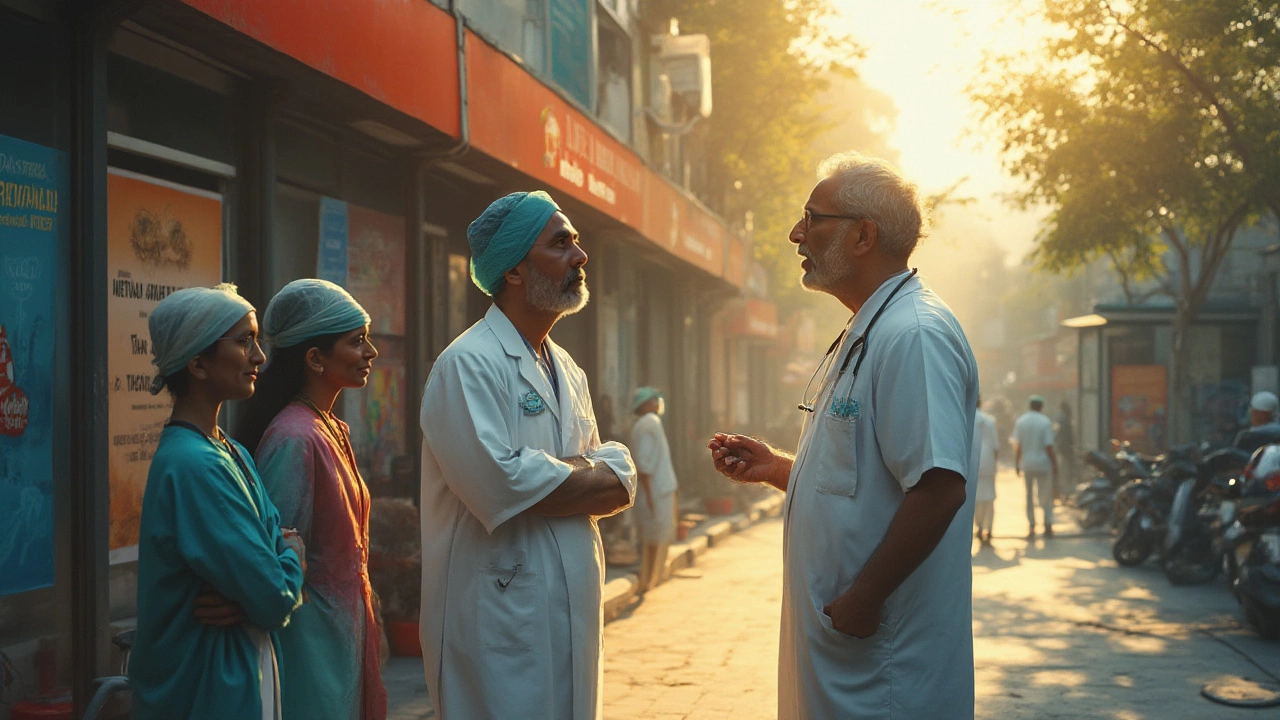Do you ever think about where medicine meets massive money? The richest doctor in the world doesn’t just heal patients—he rewrites what it means to succeed in the medical world. Forget about the old-fashioned picture of doctors working endless shifts in crowded hospitals. Some white coats have gone way beyond the clinic and landed on Forbes lists, private islands, and luxury yachts. But who really sits at the top? And more importantly, how did they get there?
The Legend of Dr. Patrick Soon-Shiong: Billionaire Doctor Extraordinaire
When the conversation turns to the richest doctor on the planet, Dr. Patrick Soon-Shiong’s name is the one that crowds out the rest. Born to Chinese parents in apartheid South Africa, Patrick’s story reads like something out of a Hollywood script. He finished medical school in his teens, emigrated to North America, and used his medical background as a springboard—not the finish line. By July 2025, his net worth is estimated at a mind-bending $9 billion, making him the undisputed heavyweight among medical moneymakers.
So, how did Dr. Patrick Soon-Shiong transform from a surgeon to one of the world’s richest people? He started out as a transplant surgeon, pioneering new diabetes treatments. But the mind-boggling leap came when he invented Abraxane, a groundbreaking drug for cancer. The therapy quickly got snapped up by hospitals around the world, and Patrick’s pharmaceutical company, Abraxis BioScience, got acquired for billions in 2010. Not one to sit still, he then moved on to NantWorks, an intricate web of tech, health, and biotech ventures. Owning over 50 patents and being involved in everything from AI to genomic research, Dr. Soon-Shiong seems to have his fingerprints on the future of medicine itself.
But here’s a little tidbit: Dr. Soon-Shiong also bought the Los Angeles Times, so his influence creeps into news and media too. Talk about diversifying!
What sets him apart isn’t just the numbers in his bank account or the zeroes in his stock holdings. It’s his knack for spotting opportunity where others only see routine. From running clinical wards to running billion-dollar boardrooms, his career shows that medicine and money don’t have to be strangers. He demonstrates one simple idea—solving big, expensive problems in healthcare can be massively rewarding, both for patients and for those who innovate.
Think about it. He could have stayed in the hospital system, worked his way up to chief of surgery, retired with a nice house by the sea. But there’s something different about people at this level—they see a bigger picture. And unlike most doctors who settle for the steady path, Soon-Shiong risked it all by stepping into the volatile business side. He teaches us that real wealth comes when you jump at those rare, high-impact chances—like inventing a drug that saves lives globally or merging high-tech with healthcare in ways nobody thought possible.
But the story isn’t just about him; it’s a blueprint for anyone drawn to medicine and wondering if this field can ever lead to the kind of mega wealth seen in Silicon Valley. Turns out, with the right innovation, medicine isn’t just noble—it’s lucrative at the very top.

More Millionaire and Billionaire Doctors: Who Else Made the List?
While Dr. Soon-Shiong is in a league of his own, plenty of others have built shockingly large fortunes through medicine, business, or both. Some tried their luck as TV personalities, like Dr. Mehmet Oz, known for his talk show, with earnings launching his net worth well past $100 million. While he never breached the billionaire mark, he proved that turning medical expertise into mass entertainment has its own payoff.
Then there’s Dr. Thomas Frist Jr., a co-founder of Hospital Corporation of America—a hospital network with a lion’s share of private medical centers across the US. As of 2025, Forbes lists his net worth at around $20 billion. But here’s the catch: Thomas Frist Jr. inherited some of his wealth and was always in the business side more than the lab coat world. People can debate if he counts as a "doctor’s doctor" or a businessman first.
In the UK, Dr. Gary Michelson’s rise to billionaire status is another wild example. An orthopedic surgeon with over 950 patents, mostly for spinal surgery devices, he eventually sold his inventions to Medtronic for $1.35 billion cash. He’s not as famous as the TV docs, but he keeps cranking up his net worth through quiet, relentless innovation. If you’ve ever wondered how much new inventions in medicine can be worth, Michelson’s story gives an eye-watering answer.
And Africa’s Dr. Precious Moloi-Motsepe shouldn’t be left out—her massive fortune is tangled together with business and philanthropy. She married Patrice Motsepe, South Africa’s mining billionaire, but as a doctor and entrepreneur, she’s made her own impact by launching medical initiatives and fashion foundations, putting her net worth close to $200 million.
It’s clear: the money trail doesn’t just run through hospitals and clinics. Many rich doctors spot opportunities in health tech, medical devices, and pharmaceuticals, or they simply turn their fame into lucrative businesses. A medical degree opens up far more than a traditional practice, especially if you’re ready to zig while everyone else zags.
If you’re just starting in medicine, that might raise a big question: is a regular family doctor ever going to see money like this? The honest answer: probably not. Most of these ultra-high net worth docs broke away from the regular 9-to-5, put their savings and reputations on the line, and chased ideas with world-changing (and wallet-changing) impact. It’s a rare path but not impossible for those craving to build something big.

How Top Earning Doctors Made Their Fortunes: Lessons, Tips, and Takeaways
So what can you learn from the paths these doctors blazed? The biggest surprise is, it’s rarely just about being the best at surgery or medicine. Sure, clinical skills open doors, but you’ll notice all these doctors did something extra—they saw massive problems in the system and tackled them with invention or business-savvy moves.
Here’s a breakdown of what stands out about the world’s wealthiest doctors—and what anyone, med student or not, can snag from their playbook:
- richest doctor stories often start with specialization. Most billionaires and multimillionaires in medicine didn’t just stick with general practice – they got deep into a niche before scaling up with new inventions or businesses.
- They partnered up. You won’t see ultra-rich doctors working alone. Frist joined forces to build hospital networks. Soon-Shiong collaborated with pharma giants. Find people who complement you.
- Patience matters. It sometimes took decades before fortunes materialized. Michelson worked for years on his patents before the big payout.
- They took calculated risks. Selling your company, inventing a risky new treatment, or jumping into media aren’t safe bets. But the biggest wins required big, well-thought-out gambles.
- Diversify your output. Being a surgeon pays well, but adding on patents, speaking gigs, or launching a company can spin off extra income streams.
- Get familiar with the business side. Doctors who learned to read a balance sheet, pitch investors, or run a company could leverage small success into huge ones. If numbers scare you, consider basic finance or entrepreneurship courses.
- Intellectual property counts. Gary Michelson's wealth mostly came from patent ownership. Learn the basics of protecting and monetizing ideas if you spot a gap in healthcare.
- Look for pain points in healthcare. All these top earners found a problem lots of people experienced and created a fix—whether it was a new device, a better cancer drug, or more efficient hospitals.
- Some built their brand or leveraged their name, like Dr. Oz or Dr. Phil, showing you don’t have to invent a medicine to cash in on your expertise.
On top of these practical lessons, the world of top-earning doctors shatters the stereotype of medicine being a "safe but unspectacular" career. Sure, the odds of reaching billionaire status as a physician are slim, but the ones who succeeded show it’s not impossible if you pursue the right opportunities. You might work side-by-side with the next Patrick Soon-Shiong at med school—or, who knows, maybe it’s you.
If you’re dead set on chasing this dream, here’s a tough-but-true tip: get comfortable with both science and business. The future of huge wealth in healthcare isn’t reading MRIs 12 hours a day; it’s inventing, building, investing, or scaling ideas that make the whole system better.
And remember, while only a handful of doctors will ever crack the billionaire club, those who do really prove that medicine, invention, and business hustle can flip the normal script—and take you places even non-doctors envy.




